
It’s a new year, and that means a fresh start, but are you still struggling with the same lead generation issues from a stagnant website? If this is you, then you already know a change is needed to generate leads, but the question is… How?
THE TRUTH:
You may have a good website with great content, but is google penalizing you for things you cannot see? Even veteran web developers often miss these details. I would like to show you how you can diagnose your own issues immediately. A few tweaks may be the secret to your future success!
Let’s get started with what is killing your website ranking and costing you free leads.
Improper Meta Tags – (Title Tags & Descriptive Tags)
These snippets of information are one of the first things Google scans when determining what content is relevant to a SERP (Search Engine Results Page). It is important to have the Title Tags and Descriptive Tags properly match the content on your web pages. For example, if someone is searching for “Auto Body Repair” it is important to have that keyword, and/or family of keywords within your Title Tag (See example below).

The top organic listings in a SERP have relevant keywords, and related keywords spread all over their Title Tags, Descriptive Tags, and ultimately their web pages.
See the trend here? From top to bottom, you must do what you say you do, and Google looks for that consistency. You cannot say in a Title Tag that you provide Auto Body work and then chat about oil changes on the same page. It must be focused, relevant content to rank well in organic search.
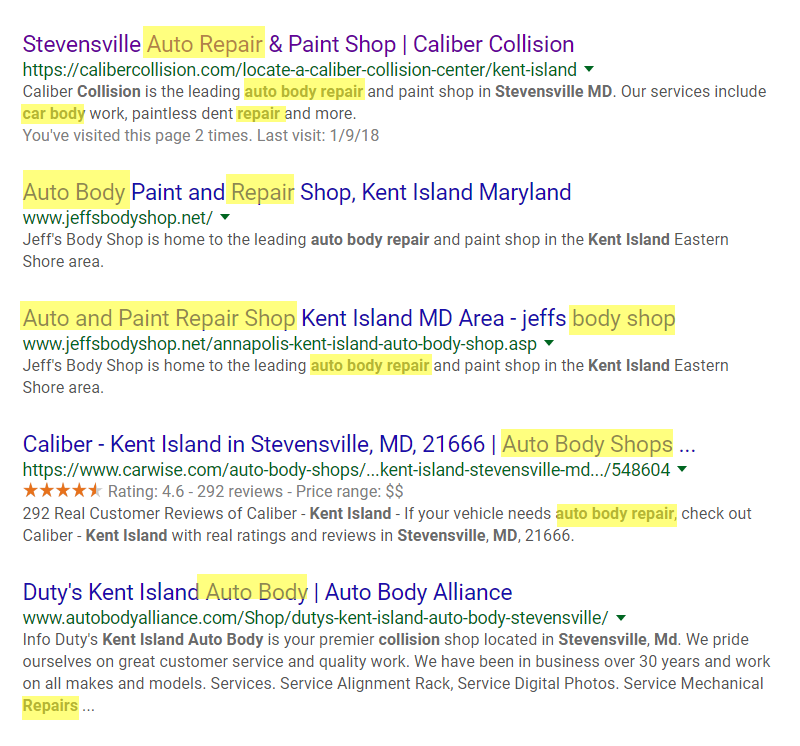
In December of 2017, Google recently doubled the Meta description length from 160 to 320 characters. This allows you to provide more descriptive detail about your business message in the SERP. Now is the perfect time to take advantage of this expansion and revisit your Meta Tags while doing so.
Also, when creating new Title Tags, make sure they are unique for each of your pages to avoid duplication penalties. You should practice doing organic searches in your category to make sure your Title Tags do not look like your competitors. You want to avoid “sameness” even if it means using dashes instead of bars to distinguish yourself from the rest.
The goal here is for your Title Tags and Descriptive Tags to stand out and generate a click. Google does look at Click-Through Rate (CTR) as they want the best user experience possible. Meta Tags that get clicks, move up in organic search.
Duplicate Content
Without a doubt, if you want your website to sink like a stone, having duplicate content is a one-way ticket to the bottom. This happens when similar content shows up in different URLS. I am sure you are thinking, “I don’t have duplicate content because I haven’t copied anything or have no reason to reproduce pages.” Well, most of the time it’s a technical issue. You can create duplicate content without realizing it, so checking regularly for duplicate content is recommended.

Often, if you have several products that are very similar, and only differ by color or size, the pages may be flagged as duplicate content.
You must designate which URL you want people to see in search results. Placing canonical tags on a main page will help search engines understand which page should gain the authority and all other pages not compete for organic rank. More information about canonicalization.
Think of it this way. Too many “cooks in the kitchen” will confuse search engines, and will not be able to distinguish authority if all pages are optimized for the same keywords. Canonical tags will make that decision easier for search engines. One chef per kitchen please!
I am sure you are wondering how to check if you have duplicate content. One of the Free tools we discuss later (Google Search Console) will show you how. This is my #2 SEO killer that can’t be ignored. Here is an informative link from Google Search Console giving insight on duplicate content issues and how to fix them.
No Mobile-Friendly Website
With Google's search results now over 60% on mobile, the company has implemented a "mobile first indexing plan that could see the light of day by the end of this year" per Google's Webmaster Trends Analyst, Gary Illyes, while addressing the SMX West Conference in March of 2017. Now in 2018, Google has started to roll out the mobile first algorithm.
What does this mean for you? Well, no longer can you ignore the importance of a mobile-friendly website. The time to act is now.
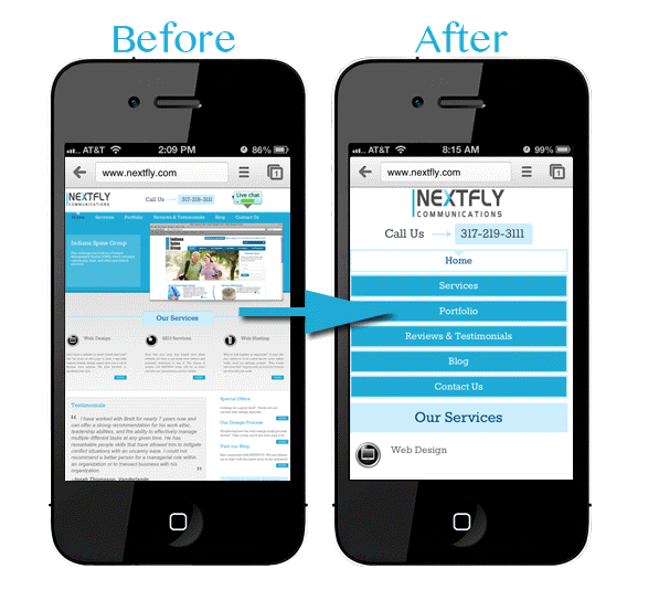
FACT: Mobile devices have less real estate to work with and have fewer tokens than desktop.
Mobile sites don't have a lot of the metadata that desktop sites have. The goal is to condense and optimize your mobile site in smaller chunks.
Here are 3 KEY POINTS to ensure you create a mobile-friendly website:
- MAKE SURE YOUR MOBILE SITE HAS THE CONTENT YOU WANT TO RANK FOR.
FOCUS ON YOUR CORE PRODUCTS - Prioritize which products are most important and rank accordingly. Think less copy and create content that is quick and easy to digest on a mobile phone. Smaller paragraphs prevent a “wall of text” issue for easier readability.
It's crucial to make navigation as easy as possible. Also, don't forget to test the mobile experience yourself to see how your customers will interact with your mobile site.
- MAKE SURE STRUCTURED DATA IS ON YOUR MOBILE SITE.
Structured Data is a standardized format Google bots read to understand what is on a web page. It then can break out numbers, dates, and groups of words and numbers called strings. A great example would be ingredients to a recipe. Structured data can allow someone to search by ingredient, calories, cooking time etc. and pick up your recipe in a search query through structured data.
Websites with structured data can also appear in a graphical search snippet. If your website does not currently have structured data, it is highly recommended that you learn more about it as Google prefers this method of organized data lists. Here is an intro guide on structured data to learn more.
- MAKE SURE REL-ANNOTATIONS ARE ON YOUR MOBILE SITE.
A rel-annotation helps Google's algorithm understand the difference between your mobile page and desktop page. Your web developer would need to add a rel="alternate" tag on your desktop to point to the mobile URL and vice versa.
These tags tie your two site versions together, so search results are better synchronized. This also helps Google pull up the appropriate version based on the device being utilized for the search.
Here are: 3 FREE TOOLS TO IDENTIFY YOUR WEBSITE ISSUES IN A MATTER OF MINUTES!
- Google SERP Snippet Optimization Tool & Meta Tag Generator
These 2 FREE tools go hand in hand as they allow you to customize your Search Engine Results Pages (SERP) and preview how your pages will appear in a Google search query.
The Snippet Optimization tool allows you to format your messaging and prevent any truncation of your content. It best used when writing unique Meta Titles & Meta Descriptions to prevent duplicate content as we discussed in our SEO killer section above. It is very important to write unique content on each page to prevent any duplicate content penalties.
Here are the quick steps.
- First, you build your Title Tag and Description Tag with your focus keyword(s) in mind. In this case, we are focusing on “FREE SEO TOOLS”.
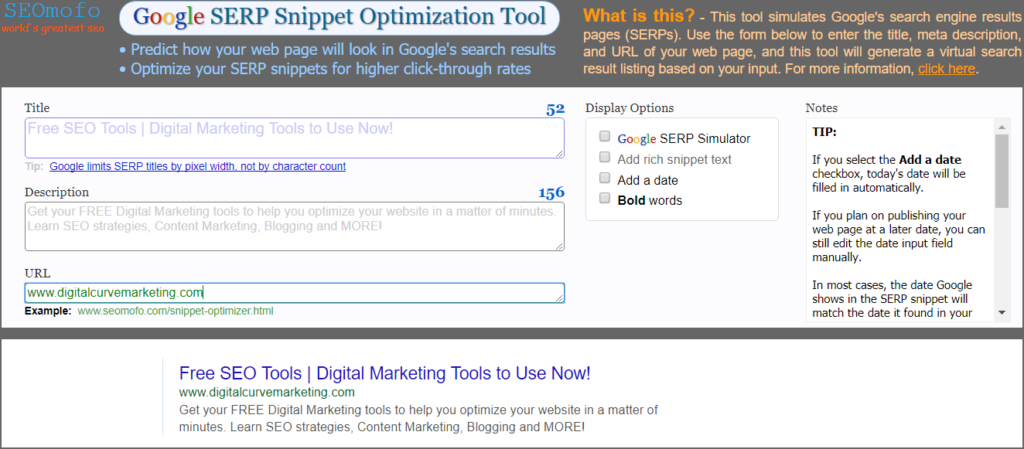
- Next, you can preview how it would appear live in a google search. This allows you to see firsthand how your keywords are placed and if you feel you are speaking to your target audience. The goal here is not only ranking, but to generate interest and gain a click.

- Third step, once you have the right content for your Meta Tags written, the question is, “How do I write the HTML code to place on my web pages?” This is where the Meta Tag Generator from SEOBook comes in.
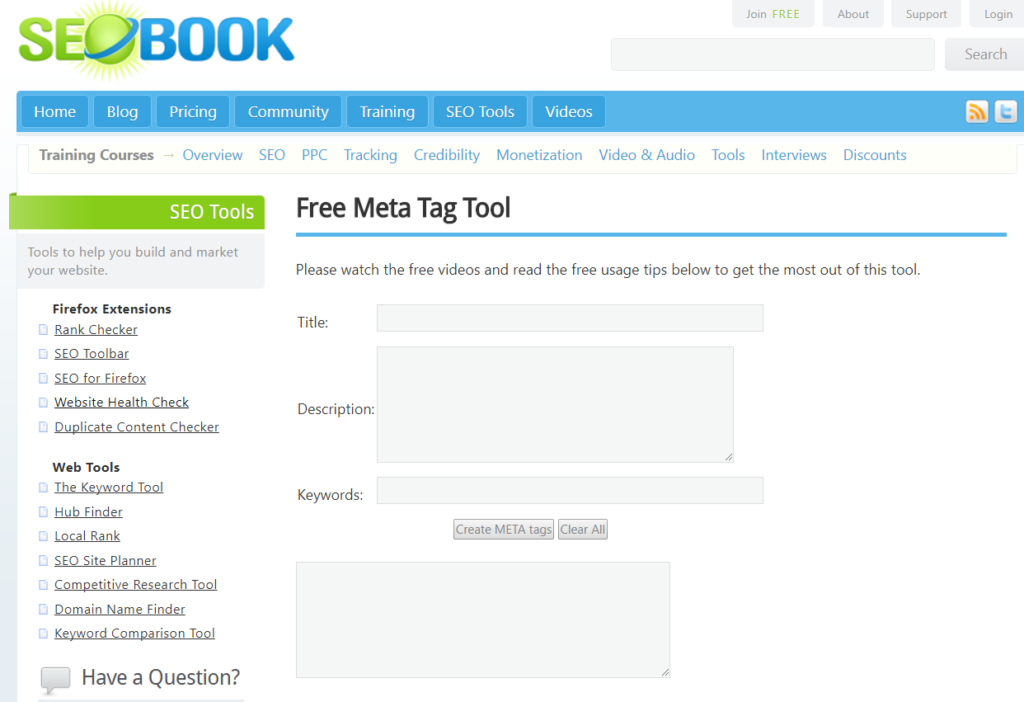
This is the second phase to completing your HTML code for your Title Tags and Meta Descriptions.
- Copy the Title Tags and Description Tags from Step 1 from the Snippet Optimization tool then click “Create META Tags” as seen in screen shot below.
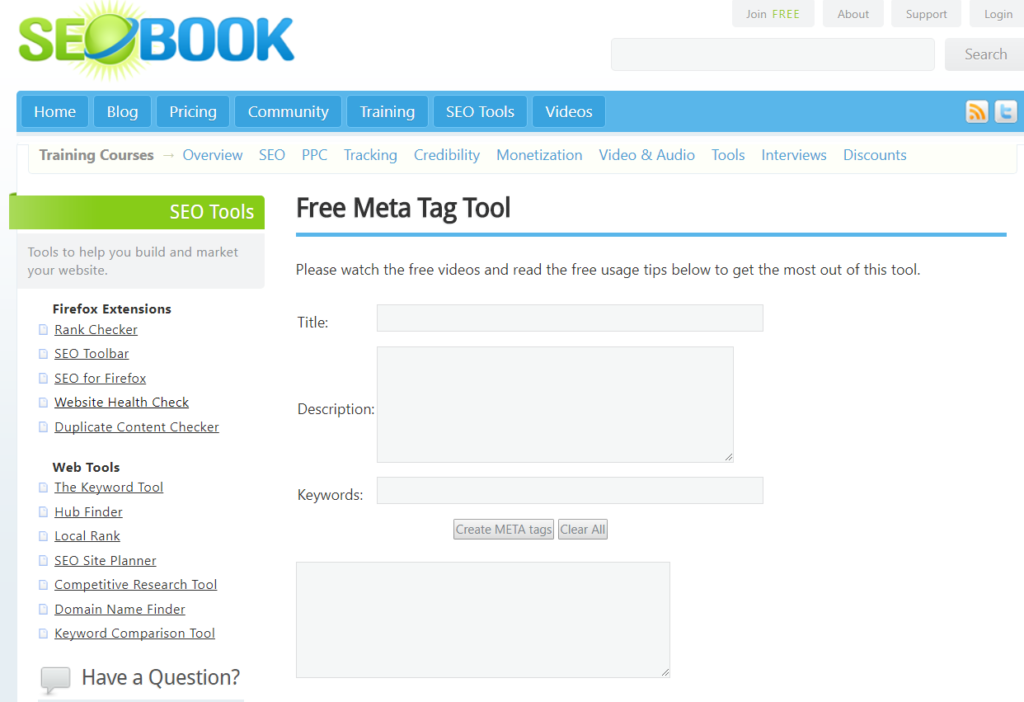
- Next, copy and paste the HTML code from the results and paste into the <Header> section of your web page.
- Copy the following lines of code and insert them between the <HEAD> and </head> tags in your HTML document. That's it!
<title>FREE SEO Tools | Digital Marketing Tools to Use Now!</title>
<meta name="Description" content="Get your FREE SEO Tools to help you optimize your website in a matter of minutes! Learn SEO Strategies, Content Marketing, Blogging, and MORE!">
<meta name="Keywords" content="SEO Tools, Digital Marketing, Content Marketing, Blogging">
Keep in mind, there are several free sites that can help you with your snippets and generate HTML codes for you, but these 2 should be part of your arsenal when it comes to free SEO tools for your META data.
- PageSpeed Insights: PageSpeed Insights analyzes the content of a web page, then generates suggestions to make that page faster. It is a FREE Google tool that will point out deficiencies in your desktop and mobile versions of your website.
PageSpeed Insights gives you a roadmap of exactly what needs to be fixed in detail.

Google takes pride in how fast it produces results in its SERP (Search Engine Results Page). If two competitive websites have quality content, Google can penalize a site with a slow page load speed.
Google is all about the user experience and providing fast results has been their forte. That is due to the high standards they expect from quick loading pages along with relevant content.
Clicking on the “Show how to fix” arrow will provide detailed information on what is needed to fix problems causing optimization issues. Sometimes, it could be a simple image that needs to be compressed to speed up loading times, or Minify CSS and Javascript files. This often overlooked FREE google tool is a “must have” in checking your website health.

- Google Search Console (Formerly known as Webmaster Tools): Another FREE web service provided by Google for webmasters. This tool allows you to check the indexing status of your pages and optimize the visibility of your website.
It looks at 4 key areas on your website:
- Site Configuration – (Preferred Domain, Sitelinks, Sitemap etc.)
- Site Health (errors, broken links etc)
- Site Traffic (website activity, demographics, audiences etc)
- Site Optimization (SEO suggestions, improvements, keyword content etc)
I am surprised at the amount of business owners that either A) are unaware of this free tool’s existence, or B) simply do not have it set up at all.
Think of this tool as a mechanic plugging your car into a diagnostic computer and analyzing the issues under the hood. The same analogy applies here. Google Search Console provides direct tips and suggestions on what is needed to pave the way for a healthy website.
It will diagnose most issues from duplicate content pages, to search traffic, and how many of your pages are properly indexed. I will walk you through the steps to set up your own personal Google Search Console.
To get started, you need to add your website and verify you are the owner of the site, webmaster, or authorized user.
How to set up Google Search Console for your business.
If you currently have a Google Analytics Account installed, the process is easy. All you must do in Google Search Console is click on the “VERIFY” button and you are all set! You must have a Google account to access Search Console, you can setup your Google account here.
- Once you have logged into Google Search Console with your Google account, in the upper right hand corner, click on the red “ADD A PROPERTY” button.

- Next, add the URL of your website and click “ADD”.
- The next segment will ask you to verify your website in a few ways.
- If you can verify your ownership through your Google Analytics Tracking ID.
- If you can upload an HTML file to the root of your website.
- If you can verify your website through your host provider. (GoDaddy, NameCheap etc.)
- Or, using your Google Tag Manager and verify with your Google Tags.
Now that you are all set up in Google Search Console, it usually takes 1-2 weeks to fully analyze your data so keep checking frequently. (The size of your website can dictate how long this process takes)
With 2018 being the year of mobile first indexing, and a changing of the guard with how we search content with our mobile devices, now is the time to take a serious look at the state of your website. These Free SEO tools are just the tip of the iceberg and can point you in the right direction to build your website as a serious lead generator.
Chad Alvarez is the Founder and CEO of Digital Curve Marketing, LLC. To learn more about SEO strategies, social media marketing, mobile-friendly web design, or anything we discussed in this article, please contact him at chad@digitalcurvemarketing.com to get a fresh start in 2018.













